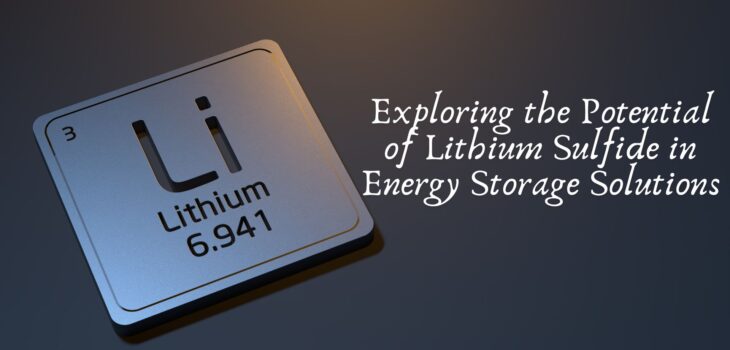 Business
Business
Exploring the Potential of Lithium Sulfide in Energy Storage Solutions
In the ever-evolving field of energy storage, the quest for more efficient, durable, and environmentally friendly solutions has led to the exploration of various materials. Among these, lithium sulfide (Li2S) has emerged as a promising candidate, especially in the context of advanced battery technologies. This article delves into the potential of lithium sulfide in energy storage systems, examining its advantages, challenges, and future applications.
What is Lithium Sulfide?
Lithium sulfide (Li2S) is a chemical compound formed from lithium and sulfur. It has garnered significant attention for its potential use in lithium-sulfur (Li-S) batteries, which are seen as a potential successor to conventional lithium-ion (Li-ion) batteries. The promise of lithium sulfide lies in its ability to deliver high energy densities, making it an attractive alternative to current energy storage solutions.
Lithium-Sulfur Batteries: An Overview
Lithium-sulfur batteries are considered one of the most promising candidates for next-generation energy storage devices. These batteries utilize lithium as the anode and sulfur as the cathode. The theoretical energy density of lithium-sulfur batteries is much higher than that of lithium-ion batteries, which could lead to more compact, lightweight, and long-lasting energy storage systems. However, the commercial viability of these batteries has been limited by several factors, including poor conductivity and the instability of the sulfur cathode during cycling.
Lithium sulfide plays a crucial role in overcoming some of these challenges. When lithium ions react with sulfur in a lithium-sulfur battery, they form lithium polysulfides, which can further react to form lithium sulfide. This intermediate compound offers potential solutions to some of the key limitations in lithium-sulfur batteries.
Advantages of Lithium Sulfide in Energy Storage
High Energy Density:
Lithium sulfide-based systems offer the potential for significantly higher energy densities compared to conventional lithium-ion batteries. This could lead to lighter and more powerful batteries for applications ranging from electric vehicles (EVs) to portable electronics and grid storage.
Cost-Effectiveness:
Sulfur is an abundant and inexpensive material, making it a more cost-effective alternative to the cobalt and nickel used in traditional lithium-ion batteries. By utilizing lithium sulfide in energy storage devices, the overall cost of manufacturing batteries could decrease, making them more accessible for various industries.
Environmental Benefits:
The use of lithium sulfide in energy storage systems could have a positive environmental impact. Sulfur is a byproduct of industrial processes such as petroleum refining, and its use in batteries could help recycle this waste material. Furthermore, lithium-sulfur batteries are less toxic than those containing heavy metals, offering a greener alternative for energy storage.
Improved Cycle Life:
One of the major drawbacks of lithium-sulfur batteries has been their relatively short cycle life due to the dissolution of lithium polysulfides into the electrolyte. However, research into the use of lithium sulfide and novel designs for the cathode and electrolyte has shown that it may be possible to stabilize these polysulfides and extend the battery’s life.
Challenges in Implementing Lithium Sulfide
Despite its promising potential, the widespread adoption of lithium sulfide in energy storage technologies faces several challenges:
Poor Electrical Conductivity:
Lithium sulfide itself has relatively poor electrical conductivity, which can hinder the efficiency of lithium-sulfur batteries. To address this, researchers have been investigating methods to improve the conductivity of lithium sulfide, such as incorporating conductive additives or designing composite cathodes.
Polysulfide Shuttling:
The formation of lithium polysulfides during the discharge cycle can result in a phenomenon known as polysulfide shuttling, where these intermediate compounds dissolve into the electrolyte. This leads to capacity loss and reduced cycle life. Solutions are being explored to stabilize the polysulfides, but this remains a significant challenge for lithium-sulfur batteries.
Volume Expansion:
During charge and discharge cycles, the sulfur cathode in lithium-sulfur batteries undergoes significant volume expansion and contraction. This can cause mechanical degradation of the electrode, leading to capacity fading and reduced efficiency over time. The use of lithium sulfide in the cathode could help mitigate this issue, but further research is needed to understand how to optimize this aspect.
Electrolyte Compatibility:
The electrolyte in a lithium-sulfur battery plays a crucial role in the overall performance. Finding a suitable electrolyte that can work efficiently with lithium sulfide, while also minimizing the formation of harmful side products, is an ongoing challenge in the development of these batteries.
Innovations and Research Directions
Researchers are exploring various ways to overcome these challenges and unlock the full potential of lithium sulfide in energy storage. Some of the most promising developments include:
Advanced Cathode Designs:
New approaches to designing the cathode material are crucial for improving the performance of lithium-sulfur batteries. This includes the development of composite cathodes that incorporate lithium sulfide with conductive materials, as well as the use of porous structures to accommodate the expansion and contraction of sulfur during cycling.
Solid-State Electrolytes:
Solid-state electrolytes offer a promising solution to the issues of polysulfide dissolution and electrolyte stability. These electrolytes could provide a more stable environment for lithium sulfide-based batteries, improving their cycle life and efficiency.
Carbon-Sulfur Composite Materials:
To enhance the conductivity and mechanical properties of sulfur-based cathodes, researchers are exploring the use of carbon-based materials. Carbon-sulfur composites could help reduce the issues associated with poor conductivity and volume expansion, leading to better performance and longevity of lithium-sulfur batteries.
Nanostructured Lithium Sulfide:
Another promising approach is the use of nanostructured lithium sulfide, which could improve both the electrical conductivity and the overall stability of the cathode. Nanotechnology may also help mitigate the issue of polysulfide shuttling by providing a more uniform distribution of sulfur and lithium sulfide within the cathode material.
Applications of Lithium Sulfide in Energy Storage
The potential applications of lithium sulfide-based energy storage systems are vast and varied. Some key areas where these technologies could make a significant impact include:
- Electric Vehicles (EVs): Lithium-sulfur batteries, with their high energy density, could enable longer driving ranges for EVs while reducing the weight and cost of battery packs.
- Grid Storage: The ability to store large amounts of energy at a lower cost makes lithium-sulfur batteries an attractive option for renewable energy storage solutions, such as solar and wind power, to help stabilize the grid.
- Portable Electronics: Lithium-sulfur batteries could power a new generation of lightweight, high-capacity batteries for smartphones, laptops, and other portable devices, offering users longer battery life and faster charging times.
The Road Ahead
While lithium sulfide holds great promise for the future of energy storage, significant work remains to be done to address the technical challenges and make lithium-sulfur batteries a viable alternative to current lithium-ion technologies. Researchers are optimistic that with continued advancements in materials science, electrode design, and battery chemistry, lithium sulfide could play a central role in revolutionizing the way we store and use energy.
In conclusion, lithium sulfide represents an exciting frontier in energy storage research. Its potential for high energy density, cost-effectiveness, and environmental sustainability makes it a key player in the development of next-generation batteries. As research progresses and new breakthroughs occur, it is likely that lithium sulfide will become a cornerstone of efficient, reliable, and eco-friendly energy storage systems.









